The Centre’s decision to bring in the Indian army to help rebuild the collapsed bridge at Mumbai’s Elphinstone Station, that saw a death toll of 20 pedestrians during the stampede, has managed to create quite a furore. Politicians and bureaucrats have been quick to decry the move that has been rightfully dubbed as preposterous.

In fact, today I am not even going to talk about ‘respect’ that is due to the army. I am simply going to base this article on pure common sense, that is, some sense and some sensibility.
And obviously the most important question one needs to ask oneself is: ‘What is an army?’
Etymologically speaking, since that is where we draw knowledge of many a terminology, the word ‘army’ is actually derived from the Latin word, ‘armata’ which means “armed force”. If we look at its historical genesis, the first recorded creation and use of an army is found around 2500 BC in Sumer, Mesopotamia. In fact, the army of Sumer was responsible for defeating the armies of Elam, which incidentally is also the first recorded war in history. In other words, since the nomadic man decided to settle down, he has had armies to guard against infiltrators and enemies. That is to say, the army has been used to ward off external threat.
So, what happens if one was to divert the energies of the army elsewhere just as we have done by asking the army to help rebuild a pedestrian bridge?
Well, it does not take a rocket scientist to figure out that if you allow your armies to focus their attention elsewhere, you are bound to leave your defences just a little vulnerable. Of course, if the nation is lucky, no one will take advantage of this weakened and vulnerable position; but truth be told, this is an unnecessary risk that can easily be avoided.
Are we really saying that in a country, especially in a city like Mumbai, that prides itself on being India’s commercial capital and has witnessed a changed skyline through its giddy rise with its myriad high-rises, is unable to build a simple bridge? Of course, we need to remember is that this is the same city that has built the beautiful Bandra-Worli Sea Link which was the first bridge in Mumbai to actually use seismic arresters that give it the ability to even withstand earthquakes measuring up to 7.0 on the Richter scale.
Of course, I am not going to discuss each individual sky-high construction projects in Mumbai to stress that Mumbai does have the wherewithal to see such construction projects through, but it does give rise to a basic question: ‘When there is no dearth of qualified civil workers in India, why do we need to bring in the Indian army to do civil work?’
After all, if the army is busy doing the job of the civil workers, who is going to do the job of the army? Of course, we don’t really need to answer the question for it is purely a rhetorical question for which history itself contains all the answers.






























A Civil Engineer in Indian Army has great future. A Typical officer in I.A generally have to work for first 8–10 years in Regiments. You can have a wealthy life if you have subject credentials on your side….